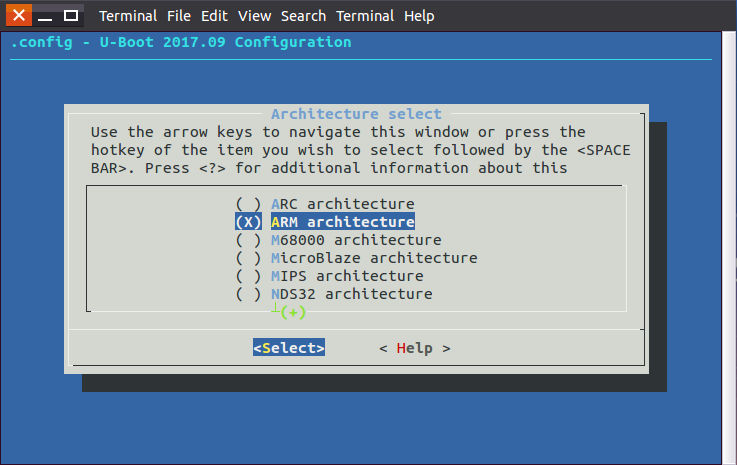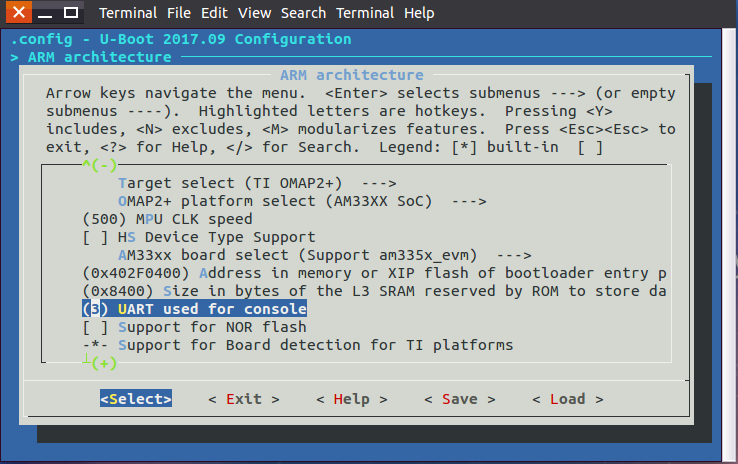1、概述
最近在做linux内核移植,内核是编译好了,只是内核导进EMMC后启动不了,移植卡在Starting kernel ...所以有必要把启动梳理一遍,看卡在那个地方。
2、Uboot介绍
3、Uboot 下载
下载: 点击打开链接
介绍:点击打开链接
4、Uboot 编译
具体步骤:
》uboot也支持menuconfig,先调用设置处理器jiagou
》选择打印串口编号,迅为的开发板为 串口3
》设置 交叉编译器
export CROSS_COMPILE=/home/cjx/Linux/Linux/LinuxTool/CompileTool/arm-2014.05/bin/arm-none-linux-gnueabi-
》设置板子类型
make am335x_evm_config
》开始编译
make
5、Uboot menuconfig 认识
> Architecture select (ARM architecture) ---> 处理器架构选择
>
> ARM architecture ---> ARM 架构子选项
>[ ] Support for ARM SMC Calling Convention (SMCCC) 支持SMCCC,这是一个开源的
Minecraft启动器核心库,SMCCC介绍点击打开链接
>[ ] support boot from semihosting 支持半主控,用于调试
>[*] Build U-Boot using the Thumb instruction set 用thumb指令建立uboot
>[*] Build SPL using the Thumb instruction set 用thumb指令建立SPL
>[ ] L2cache off
> ARM debug ---> 调试
> General setup --->
>() Local version - append to U-Boot release 版本号
>[*] Automatically append version information to the version strin
>[*] Optimize for size 优化大小
>[*] Select defaults suitable for booting general purpose Linux di│ 选择何时的启动
>[*] Enable malloc() pool before relocation 使能malloc池在引导之前
>(0x400) Size of malloc() pool before relocation malloc大小
>[*] Configure standard U-Boot features (expert users) ---> 配置标准的uboot特性
>[ ] 64bit physical address support 64位物理地址支持
> Boot images ---> 镜像
>[*] Enable support for Android Boot Images 使能安卓引导
>[*] Support Flattened Image Tree 支持扁平镜像树
>[*] Support SHA256 checksum of FIT image contents 支持FIT镜像校验和
>[ ] Enable signature verification of FIT uImages FIT uimage签名验证
>[ ] Show verbose messages when FIT images fail 打印信息当FIT镜像失败
> [ ] Select the best match for the kernel device tree 选择最好的匹配到设备树
>-*- Support Flattened Image Tree within SPL
>[ ] Enable signature verification of FIT firmware within SPL
>[*] Enable SPL loading U-Boot as a FIT
>[ ] Set up board-specific details in device tree before boot
>
> API --->
>[ ] Enable U-Boot API 使能uboot api
> Boot timing ---> 开机时序
>[ ] Boot timing and reporting 开机报告
>(20) Number of boot ID numbers available for user use 引导ID给 user
>(30) Number of boot stage records to store 引导记录数
>(0) Address to stash boot timing information 开机时序记录存储地址
>(0x1000) Size of boot timing stash region 存储区大小
>Boot media ---> 引导媒介
>
>(2) delay in seconds before automatically booting 自动引导延时
>[ ] Enable boot arguments 启动参数
>() Boot arguments
> Console ---> 控制台
>[ ] Console recording 控制台记录
>() Board specific string to be added to uboot version string
>[ ] Support a silent console 支持无信息控制台
>[ ] Buffer characters before the console is available 控制台之前有效的
字符缓冲
>[ ] Enable console multiplexing 使能控制台复用
>[ ] Select console devices from the environment 选择控制台设备根据
环境
>[ ] Allow board control over console overwriting 允许控制台覆盖板控制
>[ ] Update environment variables during console init 更新环境变量在控
制台初始化之前
>[*] Don't display the console devices on boot 在boot里面不显示控制
台设备
>[ ] Allow deregistering stdio devices 允许注销输入输出设备
>[ ] Support a FIT image embedded in the U-boot image 支持FIT镜像到
U-boot镜像点击打开链接
>() Default fdt file 默认的fdt文件
>[*] add U-Boot environment variable vers 增加环境矢量
>[*] Display information about the CPU during start up 启动显示CPU
信息
>[*] Display information about the board during start up 启动显示板子
信息
> Start-up hooks ---> 启动钩子函数
> Security support ---- 安全支持
> SPL / TPL ---> SPL是uboot第一阶段执行的代码. 主要负责搬移uboot第二阶段
的代码到内存中运行. SPL是由固化在芯片内部的ROM引导的. 我们知道很多芯片厂商固化的
ROM支持从nandflash, SDCARD等外部介质启动
> Command line interface ---> 命令行接口
> [*] Support U-Boot commands
> Autoboot options ---> 自动引导选项
>
>[*] Fastboot support ---> fastboot支持,fastboot是一种比recovery更底层的刷
机模式
>
> Info commands --->
> Boot commands ---> 启动命令
> Environment commands ---> 环境命令
>
> Memory commands ---> 内存命令
> Compression commands ---> 压缩命令
> Device access commands ---> 设备控制命令
> Shell scripting commands ---> 脚本命令
> Network commands ---> 网络命令
> Misc commands ---> 函数命令
> Power commands ---- 电源控制命令
> Security commands ---> 安全命令
> Firmware commands ---- 固件命令
> Filesystem commands ---> 文件系统命令
> Debug commands ---> 调试命令
>[ ] Enable UBI - Unsorted block images commands 是一种用于Raw Flash的
卷管理系统,主要功能是在同一个Flash芯片上管理多个逻辑卷,并且平衡整个Flash读写操作
> Partition Types ---> 分区类型
>
> Device Tree Control ---> 设备树控制
>
> Environment ---> 环境
>
>-*- Networking support ---> 网络支持
>
> Device Drivers ---> 设备驱动
>
> File systems ---> 文件系统
> Library routines ---> 库程序
> [ ] Unit tests ---- 单元测试
6、平台介绍
在分析启动流程之前先来看看自己开发板的硬件环境,我购买的是迅为的iTOP-4412开发板,开发板的核心处理器是Exynos4412处理器。芯片有两种封装,POP集成1G内存,SCP外扩1G内存(4个k4b2g),我的是SCP版,存储是eMMC KLM8G。
Exynos 4412点击打开链接采用了三星32nm HKMG工艺,是三星第一款四核处理器。主频1.4GHz,GPU 400MHz,Cortex-A9内核介绍。Exynos 4412启动点击打开链接是通过固化在iRom里的的固件程序先引导bootloader到iRam,这里的寻找bootloader位置可通过拨码开关来选择启动方式,默认从eMMC,也可选择SD卡等外设存储。引导后接着就是我们自己编译的uboot来引导内核。
7、Uboot启动流程分析
1)概述
对于CPU来说整个启动分两步,第一步是固化在芯片内部的引导,主要加载uboot.bin。这段固件应该要先判断uboot是在那个存储里面,拷贝完之后进行跳转,执行uboot.bin。第二阶段uboot.bin先初始化外设,然后初始化系统允许环境
2)初始化外设的代码
arch/arm/cpu/armv7/start.S
board/samsung/myboard/lowlevel_init.S
arch/arm/lib/crt0.S
arch/arm/lib/board.c
arch/samsung/myboard/myboard.c
start.S
1、设置CPU为SVC模式,uboot需要更多的权限所以需要打开
2、关闭MMU,uboot操作的都是实际地址
3、关闭Cache,cache主要是做缓存的,因为内存的初始化比CPU初始化慢半拍,上电之初就操作存储可能会导致问题
4、跳转到lowerlevel_init.s low_level_init
lowlevel_init.S
5、初始化时钟
6、初始化内存
7、初始化串口,看门狗
8、跳转到crt0.S _main
crt0.S
9、设置栈
10、初始化C运行环境
11、调用board_init_f()
board.c
12、board_init_f对全局信息GD结构体进行填充
crt0.S
13、代码重定位
3)准备环境阶段
arch/arm/lib/crt0.S
arch/arm/lib/board.c
1. board_init_r()是进入定制板目录的入口common/main.c
2. main_loop()中关闭中断,执行命令以及加载引导内核
4)uboot是如何加载内核的
1.uboot需要先初始化好DRAM,因为要把内核搬运到这里面
2.初始化一个串口
3.uboot需要把板子类型传给内核,按照arch/arm/tools/mach-types中的描述,将板子编号存储在r1寄存器,这里板子类型有什么用?
4.建立内核参数,包含内存位置,内存大小及根文件系统的位置等
5.加载ramfs文件系统
6.启动内核镜像

